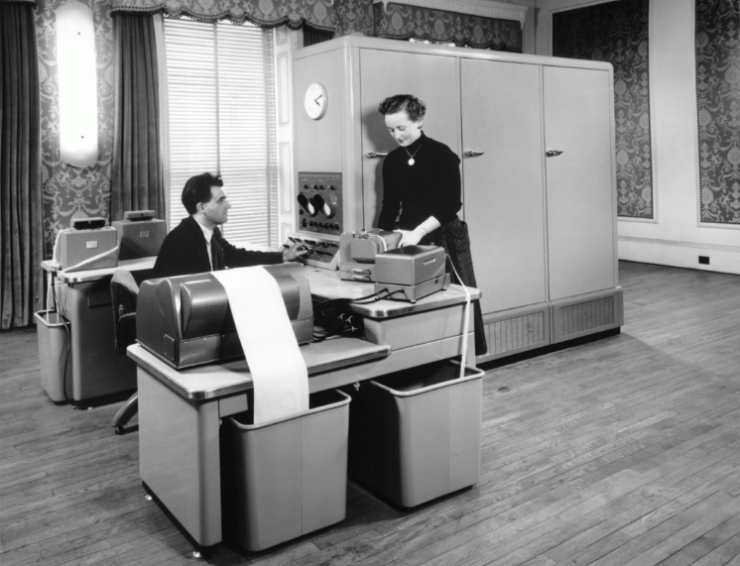
31 January 2023
In the 1960s banks were pushing technology to its limits as a result of more people opening bank accounts and the Payment of Wages Act, which allowed employers to pay certain workers in methods other than cash, including cheques and bank deposits.
This led to extraordinary developments using computers, as the first steps were taken to introduce Credit Clearing: paying in at any bank branch to another bank’s account.
Back in 1960, John Wallace, who would later rise to head of Group IT at NatWest, began work to automate the first branch of a UK Clearing Bank, the National Provincial using a computer system, initially the Ferranti Pegasus.
John joined NP in 1951 after leaving school and learned the trade stoking the boiler and taking spare cash to the Post Office with a colleague and a truncheon. Less than ten years later he was one of four staff working with Ferranti on a Pegasus serving five branches in London.
Below is an edited account of John’s experience using the Ferranti Pegasus, taken from his notes of a presentation to the British Computer Society in Year 2000 and a full-length interview to be published on Archives of IT.

“We were the four most empowered clerks in NP and had lots of authority as no-one in the bank really knew what we were doing!” John Wallace
Why Pegasus?
In the early 1960s Ferranti was a market leader, with about 25% of computers in the UK installed base.
Pegasus was produced from 1956-1962 and was one of first low cost, medium sized, multi-purpose computers. Designers adopted the package approach, which meant quick repair times by having replacement modules available.
Ferranti invited NP to carry out an experiment in 1960 using the machine and made the same offer to Westminster Bank.
During the experiment the Ferranti headquarters was visited by [the Chief Cashier of the Bank of England], Lord O’Brien [later to be its Governor] and many bank directors who were amazed that a tape from the branch could be sent to another building and the results returned.
The experiment was deemed successful, so NP ordered a Ferranti Orion: the most advanced machine of its time. However, there were delays in delivery, so NP decided to get as much experience as it could with a Pegasus 2, which was installed in 1962 in Basinghall House.
The results were that in September 1962 New Bridge Street became the first bank branch with computerised bookkeeping. That was followed by Strand, Lincoln’s Inn, Aldwych and Park Lane, all gaining invaluable experience until the Orion was handed over in May 1964.
The People
In 1960 NP appointed Ralph Hopps, Chief Inspector’s Assistant, to set up a unit within NP to assess how computers could be used in banking.
Four bank clerks were selected from branches by Ralph, trained by Ferranti as designers/programmers, who built the initial bookkeeping branch systems, wrote and implemented the programs and converted the mechanised systems.
He appointed two clerks from City Office who had NCR Postronic experience, as well as myself and Dave Hughes.
We went on a programming course, using basic machine language and had total responsibility for developing systems, preparing and converting branches.
We were the four most empowered clerks in NP and had lots of authority as no-one in the bank really knew what we were doing! The computer input was produced by paper tape on a daily basis as a by-product of accounting machines. Cheque reader sorters hadn’t been developed then.
The Computer Hardware System
Pegasus was a large valve machine: slow with operations in milliseconds. Air conditioning was achieved by opening and shutting windows. Humidity was controlled by switching the electric kettle on/off and planned maintenance was several hours per day.
There were two cathode ray tubes on controls at the front of the machine and if the program stopped a binary display gave location and content. If the reason was even parity, we’d remove the offending panel and replace it with a spare.
Data and programs were stored on magnetic tape and read down to a magnetic drum. A drum had 7K word capacity and took 16ms to rotate. There was a small immediate access store (ferrite core) of 7 blocks of 8 (39 bit) words plus accumulators to hold counts and modify instructions.
Two program instructions could be held in one word. Transfers between the drum and core were very slow and a clever programmer would optimise his program to ensure the block he wanted was coming up to the drum heads as the program reached an instruction to transfer.
All input to computer and output was on five hole punched paper tape. Branches created most of the input on accounting machines and output was fed into Flexowriters to print branch information and customer statements.
Branch Preparation
Account numbers were in the seven digits format – and a modulus 11 check digit – and shown on the cards, with three types of account – current, savings and loan. Vouchers needed to be personalised with account numbers in advance before issue to customers, and that was done in branch using embossed plates in an Adrema machine (Adrema was a well-established office ADREssing MAchine). Shortly afterwards, the E13B standard was introduced, with automatic reading of magnetic inks.
Ledger sheets were carbon copies of customer statements: information we didn’t want customers to see was stored elsewhere. A Kardex index was set up for other information – including occupation, mandatory instructions etc – and held in alphabetical order in cabinets of sliding trays.
Another card system was set up prior to transferring to the computer in account number order giving names and designations of customers. This complemented the other Kardex and was used for take-on of basic data. This and other data were sent to Basinghall House for punching into paper tape.
On D-day the branch would balance the books, list all balances and send input tapes to Basinghall House. The whole process took about nine months.
Achievements
The branch bookkeeping system formed the basis of the Orion system that followed and processed 100,000 accounts.
A cheque clearing system was developed in parallel using IBM 1400 systems and then when compatibility became an issue we decided that IBM 360 was way ahead.
Much of what was done in terms of standards and systems design still holds good today and it wasn’t achieved by technocrats, it was done by bank clerks.
I still believe that this work from the early years holds good today and its visionaries should be proud.
John gave up banking 29 years ago and since then has held multiple positions, including Chairman of CIO Connect and Honorary Treasurer of the Worshipful Company of Information Technologists.